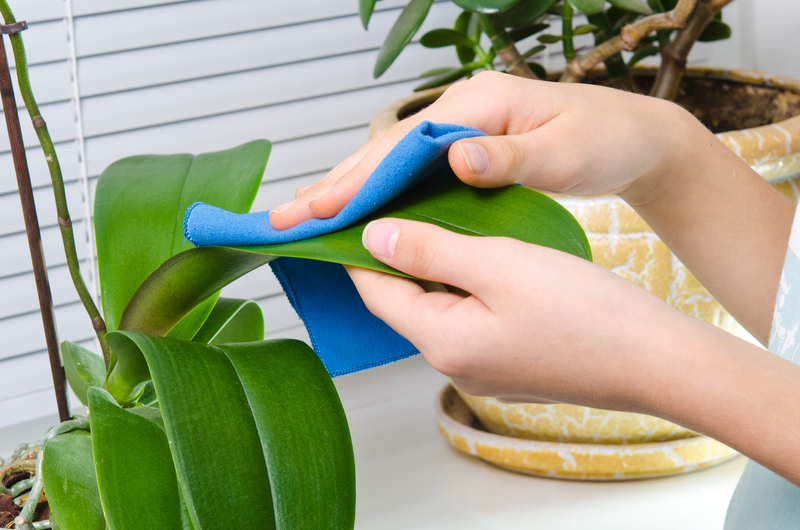Priority on Air Quality: Safeguarding Homes and Workplaces
Posted on 28/06/2025
Priority on Air Quality: Safeguarding Homes and Workplaces
In the contemporary world, air quality has advanced into one of the most significant health and wellness priorities. The very air we breathe, both at home and in workplaces, can directly impact our comfort, productivity, and overall well-being. Understanding, monitoring, and improving indoor air quality (IAQ) isn't just a trend--it's a necessity for ensuring a safe and healthy environment for everyone. This comprehensive guide explores the importance of prioritizing air quality, practical ways to protect your living and working spaces, and strategic methods to maintain optimal conditions.
Why Air Quality Should Be a Top Priority
The necessity of emphasizing air quality assurance is backed by growing scientific evidence. According to the World Health Organization (WHO), poor indoor and outdoor air quality leads to millions of premature deaths annually. Harmful pollutants such as volatile organic compounds (VOCs), dust, allergens, and microbial contaminants compromise the air we breathe in our homes and workplaces.
- Chronic exposure to pollution increases risks of respiratory diseases, heart problems, and allergies.
- Good air quality enhances cognitive function, mood, and sleep quality.
- Pollutant control can reduce the spread of airborne pathogens--vital in preventing illness outbreaks.
- Breathing clean air improves productivity, especially in office environments.
Considering the amount of time individuals spend indoors--estimated at approximately 90%--emphasizing air purification is essential. Both residential and commercial environments have unique air quality challenges that demand tailored solutions.

Key Pollutants Affecting Indoor Air Quality
To prioritize air quality improvements, it's crucial to understand the main contaminants that infiltrate our spaces. Some of the most common indoor air pollutants include:
- Particulate Matter (PM 2.5 & 10): Tiny airborne particles that can penetrate deep into the lungs.
- Volatile Organic Compounds (VOCs): Chemicals emitted from furniture, paints, cleaning agents, and equipment.
- Mold and Biological Contaminants: Spores, bacteria, and viruses that thrive in damp, unventilated areas.
- Carbon Monoxide: Colorless, odorless gas from combustion appliances like stoves and heaters.
- Radon: A naturally occurring radioactive gas that seeps from underground and accumulates indoors.
- Allergens: Dust mites, pet dander, pollen, and other particles that trigger allergic reactions.
Identifying the specific pollutants present is the first step in designing an effective air quality management plan.
Assessing Air Quality in Homes and Workplaces
Comprehensive air quality monitoring is essential to safeguarding any indoor environment. Modern technology has made this step easier through the availability of affordable monitors that detect various contaminants. Here's how to evaluate your indoor air effectively:
1. Install Air Quality Monitors
- Devices detect specific pollutants like PM2.5, CO2, and VOCs in real time.
- Choose monitors with clear alerts and historical data tracking capabilities.
2. Conduct Professional Testing
- Certified professionals can perform more detailed assessments, measuring less common toxins such as radon and formaldehyde.
- Comprehensive assessments pinpoint hidden or seasonal issues that devices may not catch.
3. Visual and Sensory Inspection
- Note visible signs like mold, condensation, or excessive dust buildup.
- Unusual odors or symptoms like frequent headaches among building occupants can signal IAQ problems.
Maintaining a routine of periodic assessment ensures air quality remains a constant priority and that improvements are effective over time.
Strategies to Improve Indoor Air Quality
From simple tweaks to comprehensive upgrades, there are a range of tactics to bolster the quality of indoor air in both residential and commercial spaces. These techniques work synergistically to limit air pollution and improve overall well-being:
1. Enhance Ventilation
- Open windows and doors whenever possible to introduce fresh, outdoor air.
- Invest in mechanical ventilation systems that exchange stale air with filtered outdoor air.
- Use exhaust fans in kitchens, bathrooms, and laundry rooms to remove pollutants at the source.
2. Optimize Filtration
- Upgrade to high-efficiency particulate air (HEPA) filters in HVAC systems and standalone air purifiers.
- Change HVAC filters regularly as specified by manufacturer guidelines.
- Consider portable air purifiers for rooms with frequent use or special needs, such as nurseries or home offices.
3. Control Moisture and Reduce Humidity
- Maintain indoor humidity between 30-50% to hinder the growth of mold and dust mites.
- Repair leaks, insulate pipes, and use dehumidifiers in damp areas such as basements.
4. Minimize Chemical Pollutants
- Choose low-VOC or VOC-free paints, finishes, and building materials.
- Opt for natural cleaning products or those with transparent ingredient labels.
- Store hazardous materials in tightly sealed containers and away from living areas.
5. Regular Maintenance and Cleaning
- Dust with damp cloths and vacuum using a HEPA-equipped vacuum cleaner.
- Launder bedding, curtains, and other fabrics often to limit dust and allergens.
- Clean air ducts and ventilation grilles regularly for proper airflow.
6. Incorporate Houseplants
- Certain houseplants, such as spider plants and peace lilies, may help filter some airborne toxins.
- Be mindful of allergy-prone individuals and pets before introducing new plants.
The Role of Air Quality in Health and Productivity
Air quality not only safeguards physical health but also drives mental performance and emotional stability. The effects are far-reaching, especially in offices, educational institutions, and healthcare settings:
- Reduced absenteeism: Clean air diminishes the spread of infectious diseases and allergen-related symptoms.
- Enhanced performance: Studies link high IAQ to improved focus, faster cognitive processing, and better decision-making.
- Long-term health benefits: People living or working in environments with clean air report fewer chronic health issues and higher levels of overall satisfaction.
By placing priority on air quality, businesses and homeowners are investing in the long-term well-being of occupants and contributing to a healthier community at large.
Addressing Air Quality Challenges in Workplaces
Workplaces present unique challenges for maintaining optimal air quality standards due to higher occupancy, diverse activities, and equipment usage. Here are essential steps to safeguard the work environment:
Establish an Air Quality Policy
- Create clear guidelines for maintaining ventilation, filter replacement, and limiting the use of problematic chemicals.
- Communicate expectations around personal behavior, like limiting fragrance and following cleanliness standards.
Monitor and Respond
- Install centralized sensors and alarms that alert management to elevated pollutant levels.
- Encourage employees to report symptoms or concerns related to air quality.
Routine HVAC Maintenance
- Service systems at regular intervals and document all maintenance procedures.
- Include duct cleaning in maintenance schedules for large buildings or those with a history of contamination.
Flexible Workspaces
- Allow hybrid or remote work options during construction, renovations, or if air quality is temporarily compromised.
- Design layouts to reduce congested areas and maximize airflow.
Safeguarding Air Quality at Home
Homes may be subject to different challenges, ranging from pet dander and cooking fumes to seasonal pollen and nearby industrial emissions. Protect your sanctuary with these homeowner strategies:
- Install detectors: Carbon monoxide and radon detectors should be standard in every home.
- No smoking policy: Ban smoking indoors to immediately reduce major air contaminants.
- Limit clutter: Minimizing unneeded objects and carpets helps reduce dust and allergens.
- Seal gaps: Fix windows and doors to prevent drafts and outside pollutants from entering.
- Educate household members: Teach everyone about the sources and risks of poor indoor air quality and healthy practices to maintain it.
Smart Technologies for Better Air Quality
The latest advancements in air purification and smart home technology make safeguarding indoor environments easier than ever. Consider integrating these tools for proactive control:
- Smart air purifiers: Automatically adjust filtration based on detected pollution levels.
- Connected HVAC systems: Provide remote control and data analytics for building managers and homeowners.
- Automated humidity regulators: Balance moisture to prevent mold and bacterial growth.
- App-controlled monitoring: Receive immediate alerts and access comprehensive reports via smartphone applications.
Investing in such solutions adds convenience and often results in long-term savings by preventing costly health or building issues caused by neglected air quality.
Regulations and Standards Guiding Air Quality
There are established air quality regulations and standards that serve as benchmarks for residential and commercial spaces. While these vary globally, key organizations such as the U.S. Environmental Protection Agency (EPA), WHO, and local health departments offer guidance on maximum pollutant concentration, ventilation rates, and best practices. Outlined below are some prevailing standards:
- EPA's National Ambient Air Quality Standards (NAAQS): Defines permissible limits on six major air pollutants.
- ASHRAE Standards (for buildings): Focuses on minimum ventilation and air handling requirements for commercial and residential properties.
- OSHA Guidelines: Sets workplace safety rules, including permissible exposure limits (PELs) for air contaminants.
Adhering to these standards and staying informed about local air quality regulations is essential for both legal compliance and the ongoing safety of occupants.

Future Trends in Air Quality Management
As technology evolves, so does the potential for improved air quality management. The future holds promising trends:
- AI-driven solutions: Automation and artificial intelligence for predictive air quality controls.
- Integration with building management systems: Holistic oversight of energy, lighting, heating, and ventilation for truly smart homes and offices.
- Health-driven building designs: Construction methods focused on sustainability, air purification, and wellness.
- Greater public awareness: Continued education campaigns encouraging communities to prioritize their respiratory health.
Conclusion: Making Air Quality a Lifelong Priority
Protecting the air quality of homes and workplaces is not a one-time project--it's a commitment to health, safety, and productivity. With escalating concerns about pollution and an increased understanding of indoor air hazards, now is the time to take effective, sustainable action. Whether you are a business leader, homeowner, or simply someone who values well-being, remember that cleaner air supports a brighter, healthier future for everyone.
By staying vigilant and proactive, adopting modern technologies, and fostering a culture that values fresh, clean air, you are making a crucial investment. Keep air quality at the forefront, and your spaces--both at home and at work--will become sanctuaries of health, resilience, and comfort.
```


